
Original Link: https://www.anandtech.com/show/2548
Introduction
Do the names Tycho Brahe and Gabriel ring a bell? If your first thought is for Danish scientists or biblical angels, you should probably just walk away from this review right now. And if you're offended by colorful language or potty humor, run - don't walk. Those of you who immediately thought of Penny Arcade's main characters probably don't need to read this review either, as it seems likely you've already made a purchase decision. For the rest of you, perhaps the best place to start is by heading over to the Penny Arcade archives and do some "research".
Anyone can critique games - after all, we're doing it - but it takes a lot more time and energy to try to create them. Long-time webcomic and pseudo-review site Penny Arcade has stepped out of the shadows and into the dark waters of game design. Joining with the people at Hothead Games, we were more than just a little curious to see what sort of offspring would result from this demonic union…. (We mean that in a good way - not all demons have to be bad, after all!)
Those of you familiar with the Penny Arcade webcomic are probably interested in knowing whether the game actually captures the spirit of PA. The setting is a new steampunk world with Lovecraftian trimmings called New Arcadia, so you won't find yourself among Twisp and Catsby or the Cardboard Tube Samurai. What you will find are Gabe and Tycho along with a few supporting characters, and plenty of snide comments, jokes, and an interesting blend of adventure/RPG/comic storytelling.
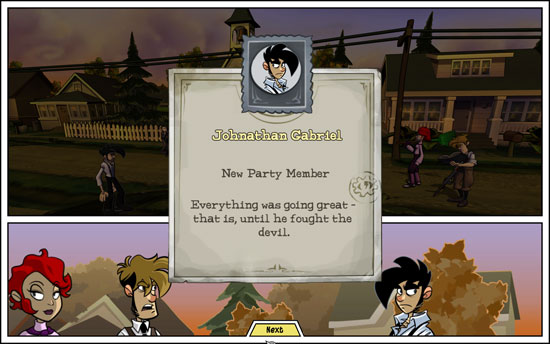 |
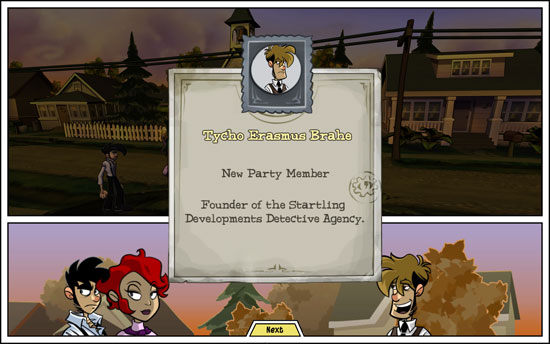 |
Many of us are fans of the Penny Arcade comics, and Mike "Gabe" Krahulik and Jerry "Tycho" Holkins have done an excellent job of posting satire, sarcasm, and invective directed at various segments of the gaming community over the years. We were more than a little curious to see what they would bring to the table when it came time for them to make their own game. The result defies easy classification; whether you'll like it or not will at least partly depend on how much you enjoy crude and vulgar humor.
Besides looking at the game itself, we also want to examine the hardware and technical side of things. This isn't a game that will push the limits of computer technology - far from it, in fact - but there are still some interesting developments… one might even say Startling Developments… that warrant discussion.
Fighting the Good Fight
On the Rain-Slick Precipice of Darkness (Precipice henceforth) at its core is a strictly linear adventure game with a few RPG trimmings. Your characters will gain levels, improve attributes, upgrade equipment, develop new skills, and fight battles - all standard accoutrements for RPGs. However, of those areas, only the battles and new levels come in a reasonable quantity.
You start the game with one character that you get to create. You can be male or female, choose from a small selection of outfits and appearance tweaks, and pick a name; then the story begins. There are a few entertaining animations as you customize your character, but outside of appearance your choices have absolutely no impact on the game. A few minutes into the game (or the demo), you join up with Gabe and Tycho and begin trying to unravel the plot, which centers around tracking down a gigantic robotic… um… fruit fornicator. (Ed: Hey, we're a family website. Penny Arcade can throw around all the cuss words they want, but we do our best to avoid dropping the F-bomb in our articles.)
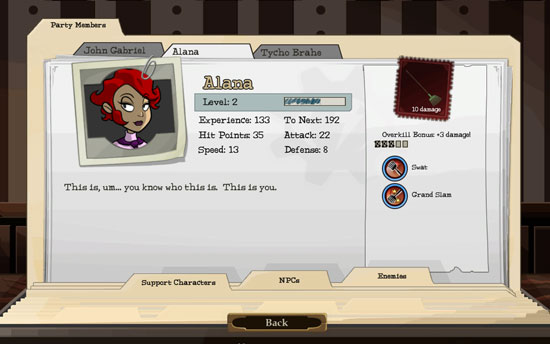 |
You get precisely zero choice when it comes to weapons and skills. Each character gets exactly one weapon (plus two upgrades to that weapon). Tycho wields a machinegun, Gabe packs a mean punch, and you… you get a rake. Unorthodox equipment to be sure, but it's part of the humor. Each character also comes with a basic attack, and as you level up you'll gain access to increasingly powerful special attacks.
The battles take place in phased combat akin to many console RPGs. Each character has three round timers that fill up in sequence that determine your range of actions. The first circle fills up quickly and gives you access to your items, the second fills up slower and allows the character to perform a standard attack, and the last fills up the slowest and gives you the ability to use your special attack. If more than one character fills up their special attack button, you can also elect to team up for increased damage. Finally, you can also attempt to block enemy attacks by pressing the spacebar at the appropriate time; do it properly and you can even execute a free counterattack while avoiding damage. Three support characters also become available over the course of the game, with timers of their own that build up (very slowly) during battles. Let's go over the different combat options.
Items fall into one of five categories. There are three items that can heal other party members and three more that cause damage your enemies. The next six either increase your abilities (i.e. better armor, more powerful attack, faster attack) or hinder your enemies (less armor, weaker attack, or slower attack). Only one effect can be in place on any character, so if a new effect is activated the old effect is disabled, creating some small amount of strategy. Finally, a few items will distract your opponents. These last two items are almost more for comedic effect than anything else - not that they're useless, but most of the items are unnecessary. By the end of the game, we found that we had maxed out our carrying capacity for every item type.
Standard attacks require little in the way of explanation; your character will either shoot, punch, or swat the selected opponent. Special attacks are a bit more involved. Each character will acquire three different special attacks over the course of the game as you level up, which become increasingly difficult to pull off to maximum effect. The special attacks can be thought of as mini games, but they can become rather tedious. Gabe's attack in particular gets old fast.
Your custom character has to press the spacebar four times as a "clock" moves around a circle. At levels two and three of the attack, the blocks that show where you need to press the spacebar start moving. Gabe requires you to press the spacebar rapidly, followed by a final timer bar where you press it one last time. Upgraded special attacks will require you to press the spacebar more/faster. (Whoopee?) Finally, Tycho's special attacks require you to press the appropriate direction arrow. You have seven seconds, and you need to press the correct key eight, ten, or twelve times - the last doesn't leave much margin for error.
If you perform the special attack properly and manage to kill your opponent, you also score an overkill. This increases the amount of damage you can do in future battles. A level one weapon can get +5 from overkills, a level two weapon allows up to +10, and the level three weapons allow +15.
The initial special attacks are simply a more powerful attack against a single foe, although your rake causes bleeding damage over time. At level two Gabe gains the ability to stun an opponent and Tycho can damage multiple foes; your character does more damage to a single foe but also inflicts additional bleeding damage after the attack. For level three, Gabe will attack all enemies with a chance at stunning them, Tycho will attack all enemies with a powerful machinegun blast, and you will do even more damage and bleeding damage.
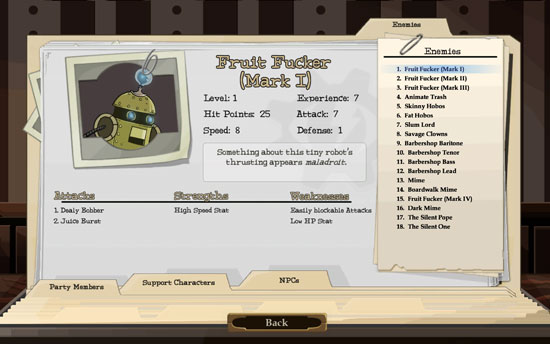 |
Combat consumes the majority of your time in Precipice, with battles against a small selection of opponents. There are the aforementioned fruit fornicators (four models of increasing sophistication), feral trash, hobos (two more variants), mimes (three variants), clowns (naturally), an evil barbershop quartet, and three unique boss characters. While combat is somewhat enjoyable at first, and some of the more difficult battles towards the end of the game add spice, as with many games there is definitely a lot of repetition involved. It's good that Precipice is only about 6-8 hours in length, because any more and the combat would begin to be truly tedious. There is some good news in that there are no random battles in the game; once an area is cleared, it will stay that way unless something happens in the story that repopulates an area with more enemies.
Once Upon a Time…
While there are a lot of battles, the real draw of the game for most people is going to be the story. In fact, we think it's best to characterize the game as something of an interactive Penny Arcade strip… only a lot longer and with a (mostly) coherent theme. Gabe and Tycho work as paranormal detectives, running their own Startling Developments Detective Agency. Gabe tends to be the brawn of the operation while Tycho provides the brains. Your character just comes along for the ride.
If you read the blog entries that go along with the Penny Arcade comic strips, you'll know that Tycho frequently writes long diatribes about random subjects, as well as providing a bit of background for the individual strips. He also laments any form of continuity between strips, and they "try" to avoid such things. One can only wonder at his horror when he began to put pen to paper and create a story that lasts several hours.
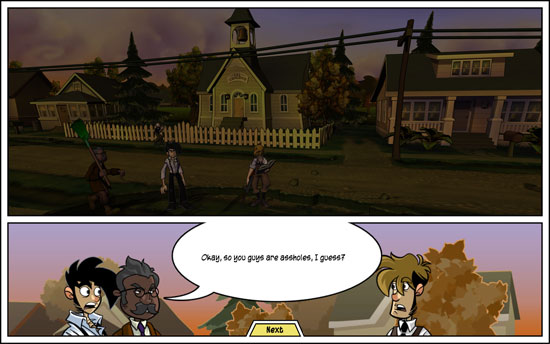 |
The story portions of the game are certainly not revolutionary, but they're the real meat of the game for fans of Penny Arcade. You get to experience the Gabe-Tycho-Other dynamic that shows up in the webcomic, and some of the comments are sure to induce real laughter - unless of course you hate the comic and all things gaming, like Jack Thompson.
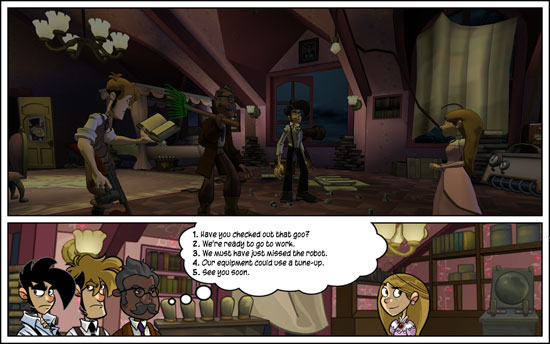 |
Conversations are your typical "multiple-choice" trees, but with few exceptions they are strictly linear. You can ask for further clarification, and sometimes you'll be given several options - i.e. why are you interested in the giant robot, Tycho wants to know, at which point you get to choose an appropriate response - but other than fleshing out the story somewhat there is no consequence to your choices. We were a little disappointed at this, as we expected at least some difference in response to some of the choices.
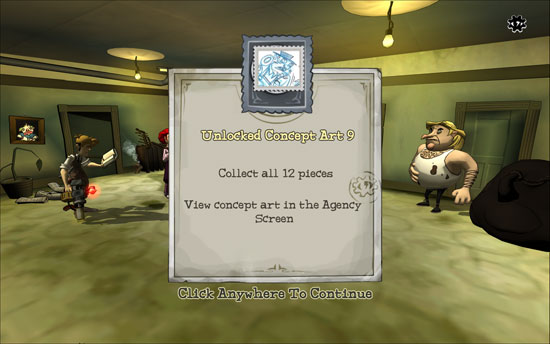 |
It's not strictly part of the storytelling, but there's also interaction with your surroundings. In standard adventure game fashion, you can click around on various objects in the environment to get text descriptions. Unlike the conversations, the descriptions generally aren't all that humorous, but there is a mini game of sorts here as you can find hidden artwork and music that you can listen to back at the Startling Developments office. Find them all, and you even unlock a secret Penny Arcade comic.
The simple summary of the story and gameplay is that it's entertaining for roughly the duration of the game. You can play through it again, but it's not as good the second time around… rather like reading and rereading the same comic strip. Once you know the punch line, it's not as funny. I've purchased Penny Arcade books for about the same price as the game, and they provide about the same amount of entertainment. That's coming from a fan of their work, of course, so adjust your expectations as appropriate.
Performance Analysis
We've run some performance tests on Precipice, focusing mostly on the Windows version of the game. Anand played the game on his MacBook Pro and will chime in with additional input here (Ed: Check back later today for an update), but the short summary is that the game isn't all that demanding of computer hardware. That shouldn't come as too much of a shock, considering the whole game fits into a 208MB download. If you have even a moderate PC, you should be able to play Precipice. What about low-end hardware, though? We'll give the game a shot on an IGP solution as well, just for good measure.
| Custom X38 Test System | |
| Processor | Core 2 Quad Q6600 (2.40GHz 2x4MB
cache) Overclocked to 3.00GHz (QX6850) |
| Motherboard | Gigabyte GA-X38-DQ6 |
| Memory | 2x2048MB OCZ DDR2-800 Running at DDR2-800 4-4-4-12 |
| Graphics | 2 x AMD Radeon HD 3870 (CrossFire) |
| Hard Drive | Samsung F1 750GB (7200RPM 32MB) |
| Operating System | Windows Vista Ultimate 64-bit |
| . | |
| Dell XPS 630 Test System | |
| Processor | Core 2 Quad Q6600 (2.40GHz 2x4MB
cache) Overclocked to 3.00GHz (QX6850) |
| Motherboard | Dell nForce 650i |
| Memory | 2x1024MB DDR2-667 Running at DDR2-667 5-5-5-15 |
| Graphics | 2 x GeForce 8800 GT 512MB (SLI) |
| Hard Drive | Seagate Barracude 7200.10 500GB (7200RPM 16MB) |
| Operating System | Windows Vista Home Premium 32-bit |
| . | |
| Gateway 530FX Test System | |
| Processor | Core 2 Quad QX6700 (2.66GHz 2x4MB
cache) Overclocked to 3.00GHz (QX6850) |
| Motherboard | Gateway 975X Motherboard |
| Memory | 2x1024MB
DDR2-667 Running at DDR2-667 5-5-5-15 |
| Graphics | ATI Radeon X1950 XTX 512MB |
| Hard Drive | 2 x 150GB Western Digital Raptor (RAID 0) |
| Operating System | Windows Vista Ultimate 32-bit |
| . | |
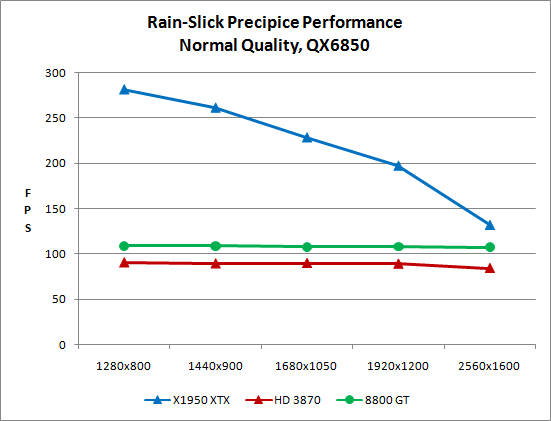
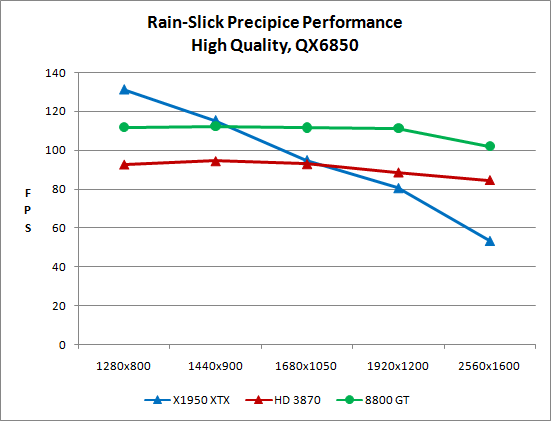
All three test systems are running more or less the same processor: a quad-core Kentsfield running at 9x333MHz (3.0GHz). Memory type and amount varies somewhat (two systems have DDR2-667), but the more noteworthy aspect is that the X1950 XTX system runs much faster when the GPU doesn't limit performance. We're clearly not CPU limited on the X1950 XTX at higher resolutions, and we're not GPU limited on the 8800 GT and HD 3870 at lower or higher resolutions. So what's going on? As best as we can tell, there are driver limitations that are capping frame rates. Also note that SLI and CrossFire testing showed no improvement in performance. While all of that may be interesting on some level, it's important to pay attention to the fact that frame rates on the newer cards are all well over 60 FPS.
There are a few other interesting items related to performance. For one, the game appears to apply 4xAA regardless of detail setting. Given the relatively simple graphics complexity and the comic book styling, anti-aliased edges are a nice addition. However, anti-aliasing does have a performance requirement, and the impact is likely to be felt on lower end graphics hardware. The other point of discussion is that the only two detail settings are "Normal" and "High". Texture and lighting quality improve on High, and many of the edges get black borders, emphasizing the comic styling. On appropriate hardware, there's no reason to run at Normal detail, but High detail does require SM3.0 support and runs at about half the performance of Normal detail (assuming you're GPU limited). You can see the difference between the image quality settings in the above gallery.
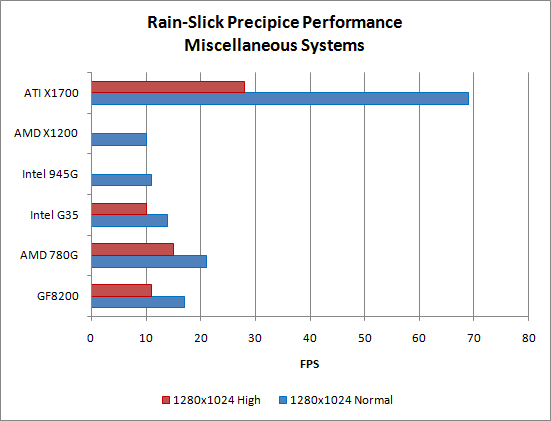
We did some quick testing of Precipice on a few other systems, specifically looking at performance on some of the most common IGP solutions. Note that these tests are not at all equivalent hardware in many cases, as the CPU used varied quite a bit. However, we are generally GPU limited with these systems; the slowest system is an aging 945G laptop with a Core Duo T2050 (1.66GHz) and 1GB DDR2-533. The ATI X1200 has 2GB of RAM with a Turion X2 TL-64 (2.0GHz). We performed all testing at 1280x1024 (using an external display).
High detail isn't an option without SM3.0 hardware, so the X1200 and 945G are limited to Normal detail. Unfortunately, even that proves to be too much, with performance hovering just over 10 FPS and frequent drops into single digit frame rates. Lowering the resolution didn't improve performance much at all, with 800x600 only running about 20% faster than 1280x1024. Simply put the IGP solutions from two or three years back won't run Precipice at acceptable frame rates.
Moving to the upgraded GMA X3500 on the G35 chipset, performance improves slightly and we also gain the ability to run in High detail mode. Normal detail at 1024x768 is marginally playable, but you'll really want something better. The GeForce 8300 improves slightly on the G35, but the best IGP solution right now is obviously the AMD 780G. At standard clocks, the 780G manages just over 20 FPS at 1280x1024. That probably seems quite low, but the gameplay is such that anything above 20 FPS is tolerable, with 30 FPS being more than sufficient. Overclocking the GPU from 500 MHz to 750 MHz on the 780G improves frame rates by around 20%.
In summary, while the game isn't very demanding on built-for-gaming PCs, it appears that you'll want at least 780G level hardware if you would like to run at moderate (i.e. 1280x1024) resolutions and Normal detail. Discrete graphics cards of the GeForce 7600 or Radeon X1600 level or higher should have no trouble with Precipice at up to 1680x1050 (possibly higher depending on the card) on Normal detail. As a reference point, a Radeon Mobility X1700 laptop (roughly equal to an X1600 Pro) resulted in nearly 70 FPS at 1280x1024 on Normal (and 61 FPS at 1440x900), but High detail drops performance down to around 28 FPS.
Graphics memory bandwidth is definitely a factor in performance because of the use of anti-aliasing. It would have been beneficial to give users the option to turn off the AA, particularly on low-end IGP solutions. As an example, in non-bandwidth limited games, the G35 performs significantly better than the 945G (usually at least twice as fast). It is around 30% faster in Precipice, but we would have expected more. The same holds for the 780G and GF8300 relative to the 945G.
Technical Considerations
For the most part, the game was trouble free, but there are still some technical considerations to bring up. The major one concerns the distribution system. At present, Precipice is available through several sources. The first is direct from the new Penny Arcade spinoff Greenhouse, where you can download the trial version and buy a license for $20 (the demo contains the full game). The game is available for Windows, Mac, and Linux platforms. (Ed: We never got around to trying the Linux version, so we can't comment on it.) The game is also available via Direct2Drive, but at the same $20 price point that's more an advantage for improving visibility of the title rather than something that benefits consumers. Valve's Steam is another option, again at the $20 price point. Finally, the game is available from Xbox Live Arcade for 20 XBLA points, for use on your Xbox 360. We haven't tried that version of the game, however, so we'll confine our review to the PC versions. Steam users may be partial to that platform, if only for the addition of some Steam Achievements for the game. We played the version that came via Greenhouse.
Concerning DRM - and we hesitate to use that term - there are a few interesting items to discuss. First, it's a well-known fact that the DRM protection measures in most gaming titles are now circumvented within days of release - sometimes even before the official launch. Perhaps somewhat surprisingly, the availability of a cracked version of Precipice has not occurred (as far as we're aware). That's good for them, as it suggests more sales and fewer pirated copies. It also means that their security appears to be better than that used on other games - or at least the "crackheads" of the Internet aren't interested in attacking it, which seems more likely. However, there are a few concerns when it comes to installing the game on more than one PC.
The current setup is that you get a single license code that can be used to install the game three times. You can use the same code for Windows, Linux, or Mac OSX, but you only get three installs. (Note: that number may have changed; see below.) Once installed, there is no further online communication required to play the game; however, it does appear that certain hardware changes - a new motherboard for example - may invalidate the installation and require you to activate it again. We were able to determine that copying the activation files over to a different PC invalidated the install.
So far so good, but what we haven't been able to determine is what happens once you pass the three installations mark. We received two keys; the first one only installed once and then refused to install elsewhere, and the second has now been installed and activated on more than eight PCs. Hothead Games can apparently adjust the number of allowed installations on a key, so we're not entirely sure what normal behavior will be. More specifically, we are concerned with long-term prospects for game installations.
What happens if you install the game on two or three PCs today (i.e. a laptop and a desktop and your work PC), and over the next year you upgrade components or systems and you now need to reinstall the game? If you're the type of person that returns to a game a few times over the years, Precipice may end up requiring a few emails to the support people. We were unable to determine whether uninstalling would return one of the allowed installs, as neither of our keys is "normal", but that does not appear to be the case. Hothead has stated the following, however, so all of the above is probably making things out to be worse than they are:
"We don't anticipate having to limit the number of redownloads but remember that each new machine or major hardware change may trigger a new key to be issued against your license. Our plan is to allow multiple installs and to be generous in that regard to cover murdered systems, planned upgrades, people wanting to play it on their PC and their Mac or even Linux box etc. Even if the limit is reached - a limit that we have not determined yet - we will be flexible in resetting or increasing the limit for paying customers. If you are registered, we will keep your license keys stored for you in your profile and you will be able to see the number of times that license has been used for various systems so there will be no surprises."
What we end up with is something similar to the Bioshock situation, but with a title that isn't quite as high on the "must have" list. Bioshock eventually did relax their number of allowed installs, and the Precipice developers seem to have a similar approach in mind. Honestly, it's probably not a huge concern. Given the lack of multiplayer, and the fact that the game isn't too demanding, the licensing policy should be acceptable to most gamers; just know in advance that you may not easily be able to install and activate the game more than three times. As it stands, the game is enjoyable for a quick romp, but we likely won't be heading back to New Arcadia repeatedly over the coming years to relive old exploits.
We've already mentioned that anti-aliasing is always enabled, and it would have been nice to get an option to disable it. The one other noteworthy technical detail to mention is that similar to Assassin's Creed, Precipice takes the approach of forcing a letterbox/widescreen gaming experience on players. The game will fill the whole screen on 16:9 and 16:10 aspect ratio resolutions, but on 4:3 or 5:4 aspect ratios you will have black bars on the top and bottom. Users that continue to run standard AR displays will probably be somewhat upset by this approach, but as a proponent of widescreen gaming I find it hard to get too upset. Given the number of titles over the past several years that have lacked adequate widescreen support, a change in the tide on occasion is welcome.
Conclusion
How good of a game is Penny Arcade Adventures: On the Rain-Slick Precipice of Darkness, Episode One? Besides having the longest name we can recall, we feel the game is entertaining and worth checking out for all the computer geeks of the world. If you focus on the first two words of the title, it will probably tell you a lot about whether or not you will enjoy this game. To paraphrase a recent posting by Tycho, we could simply say, "If you like Penny Arcade, then you will like Penny Arcade Adventures - that's a tautology most people should be able to grasp." However, Penny Arcade Adventures isn't exactly the same as the Penny Arcade webcomic, so it's not a perfect tautology.
If you have no idea what Penny Arcade is about, a good place to start would be visiting their website and reading some of their past comics. Unlike many traditional comics, you can find the entire catalog of Penny Arcade at the website, dating all the way back to November 1998 and the glory of SiN load times. Not every comic is laugh out loud funny, and some people will be offended by the site's content. We can say with reasonable assurance that if you find the Penny Arcade website offensive, you will also be offended by the game. Proceed at your own discretion.
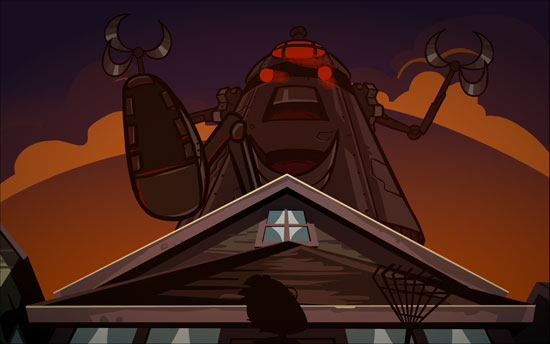 |
Another option that's nice to have for testing had a game is the freely available demo. That might give you an idea of whether or not the game is something you would enjoy; however, we have a few reservations about coming to a final judgment based on the demo. The main one is that the demo is full of a running narrative providing a bit of background information as well as a brief tutorial. It is very likely that some people will look at the demo and think, "I'm getting really tired of the narrator!" Thus it is important to mention that the narrator pretty much disappears at the point where the demo ends.
Where does Precipice fall in relation to other games? It's not at the technological level of any major RPG of recent history (i.e. Oblivion), and neither does it have the complexity of most PC RPGs. The gameplay has more in common with console RPGs, and any "role-playing" is decidedly light. What you're getting is a story that involves the Penny Arcade characters, dressed up in a low-cal RPG sauce. While there's a lot of combat, the game feels like an adventure in some respects, so there are parallels to games like Sam & Max. If you are entertained by the Sam & Max episodes, I think there's a reasonable chance that you'll like Precipice. It's not that the two are very similar, but I got about the same amount of enjoyment from Precipice as I get from a Sam & Max episode… and I certainly laughed more during Precipice.
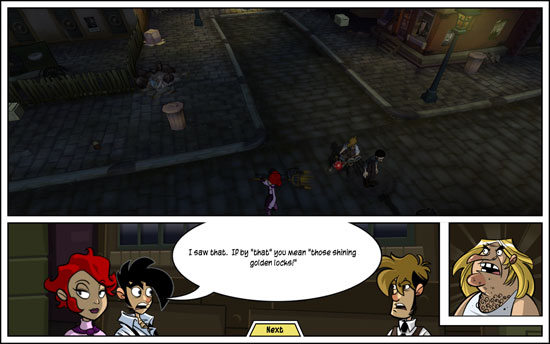 |
In short, Precipice isn't the type of game that's going to turn the industry on its head. It really brings nothing new to the medium, being content to provide a relatively short but still entertaining "RPG-lite" experience. There's nothing wrong with that, so long as what's provided is worth playing. Several of us enjoyed the game, but at least one editor here felt it was pretty dull and my 14-year-old nephew told me it was "stupid". (Ed: But who actually trusts the opinion of a 14-year-old boy!?) It's not an expensive game, at least, and it won't take you months to complete; worst case, you're out $20 if you buy it and don't like it. I played it and enjoyed the setting, characters, plot, and most of the game mechanics. Sign me up for Episode Two; hopefully the release schedule will be more in line with the Sam & Max episodes than with Valve's Half-Life approach.
| Penny Arcade Adventures - System Requirements/Recommendations | ||
| Required | AnandTech Recommended | |
| CPU | Pentium III, AMD Athlon, Mac G4 1.0 GHz or better | Pentium 4, Althon XP, G5 or Better |
| RAM | 512MB of available system memory | 1GB or more |
| Storage | 350MB of available hard drive
space Internet connection required for one-time activation |
350MB of available hard drive space |
| GPU | ATI RadeonTM 9500 or better NVIDIA GeForceTM FX 5200 or better Intel GMA 950 or better 64MB of video memory OpenGL drivers required for Windows/Linux |
ATI Radeon X1600 or better NVIDIA GeForce 7600 or better 128MB of video memory |
| OS | Windows 2000/XP/Vista Mac OS X 10.4/10.5 Linux 32-bit x86 |
Any supported OS and appropriate drivers |
Videos and Image Galleries
Since a few images don't really convey a real sense of the game, we've put together some videos and galleries of dialog trees. The latter will show complete conversations that take place in a few areas, and as such they contain spoilers. The videos will focus on showing battles, and again some of these are major spoilers. You can also try the demo to get a taste of the gameplay, but we felt the game improved once you got past the demo/tutorial portion.
Can we talk?
First up is a conversation that occurs right near the end of the demo. It's your first encounter with Tycho and Gabe, providing a taste of things to come.
Next is a conversation with Anne-Claire (a.k.a. Annarchy) that occurs right after the demo ends. You'll chat with her a lot during the course of the game, and while she has some entertaining moments she doesn't hold a candle to the professor of urinology - a man who studies the effects of pee.
Anne-Claire plays a major role in the story telling, as she more or less assigns your missions. Here's the conversations surrounding the first quest.
Anne also does weapon upgrades, and the following gallery shows the conversations that take place for all three initial upgrades.
Coming soon to a theater near you…
These videos focus on the battles, as outside of the conversations (shown above) there's not much to include. The first three are relatively generic battles, the next two show some minor spoilers of things to come, and the final two show two of the three major "boss" battles. Stay away from the final two if you want to avoid spoilers! (Follow the links for additional descriptions.)
Penny Arcade Adventures - Takin' Out the Trash.
Penny Arcade Adventures - Fruit F***er Fight.
Penny Arcade Adventures - Hobocide.
Penny Arcade Adventures - Bolt Quest.
Penny Arcade Adventures - Barbershop Quartet.
Penny Arcade Adventures - Slumlord.
Penny Arcade Adventures - Final Battle.

















































